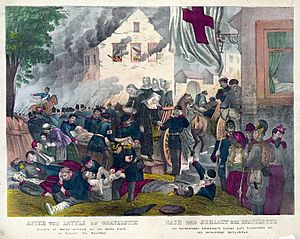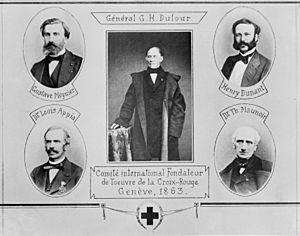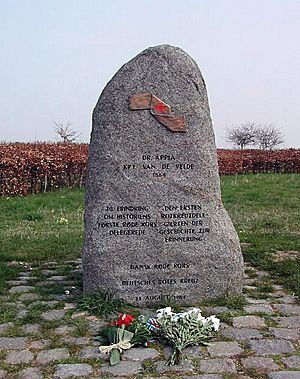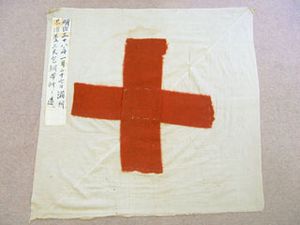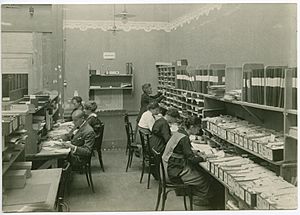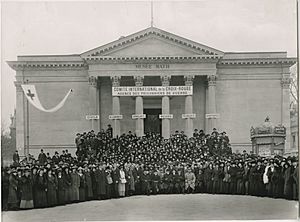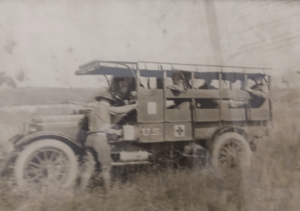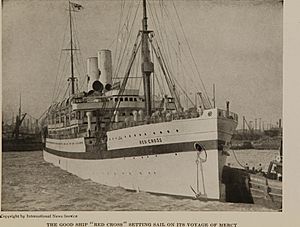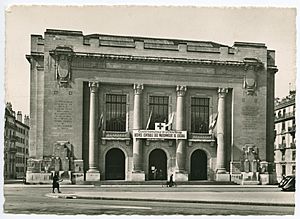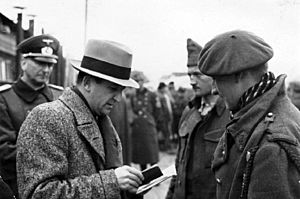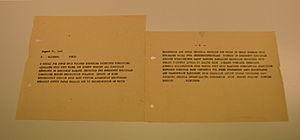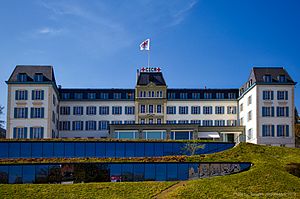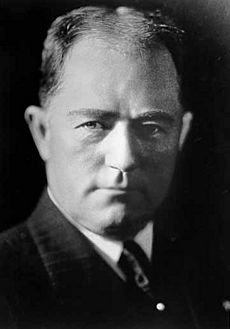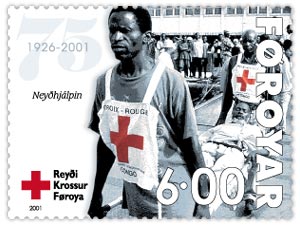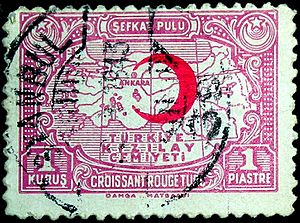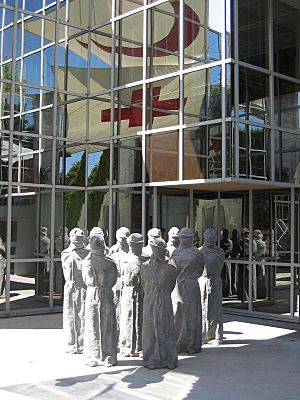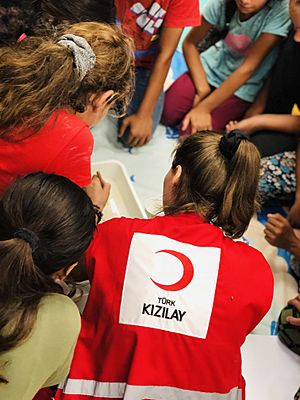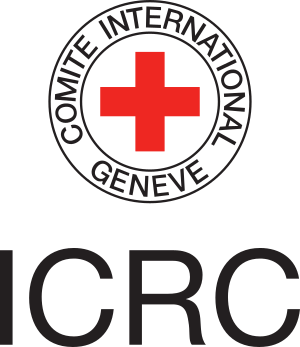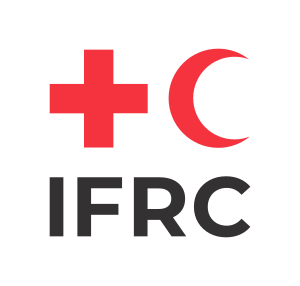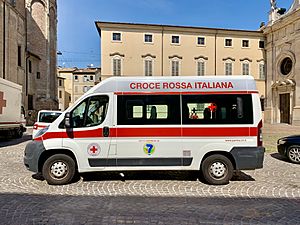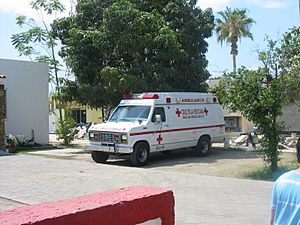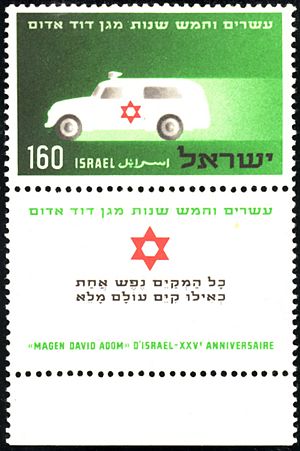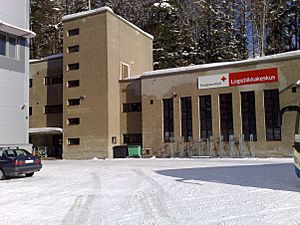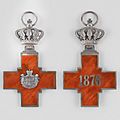International Red Cross and Red Crescent Movement facts for kids
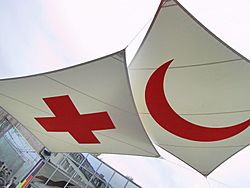
The Red Cross and Red Crescent emblems, the symbols from which the movement derives its name, Geneva, 2005
|
|

The three emblems in use:
Red Cross, Red Crescent, Red Crystal |
|
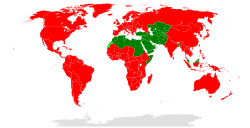
Places where the organization is based, with color distinguishing denominations around the world
|
|
| Abbreviation | ICRC and IFRC |
|---|---|
| Motto | Inter arma caritas Per humanitatem ad pacem (Latin) |
| Founded |
|
| Founders |
|
| Type | NGO, NPO |
| Focus | Humanitarianism |
| Location | |
| Origins | Geneva |
|
Area served
|
Worldwide |
| Method | Aid |
|
Membership
|
|
|
Key people
|
Peter Maurer |
|
Employees
|
c. 180,000 |
|
Volunteers
|
c. 16.4 million |
| Award(s) |
|
The International Red Cross and Red Crescent Movement is a worldwide group that helps people. It has about 97 million volunteers, members, and staff. This movement was created to protect human life and health. It also works to make sure everyone is treated with respect. Its goal is to prevent and ease human suffering. There are three main parts to the movement. They are separate but work together. They share common goals, symbols, and rules.
Contents
History of the Red Cross
How the Red Cross Started
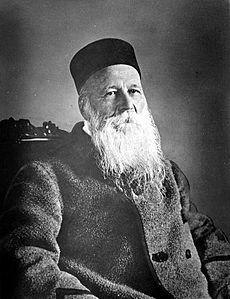
Before the mid-1800s, there were no good systems to care for wounded soldiers. There were no safe places to treat them on battlefields. A Swiss businessman named Henry Dunant traveled to Italy in June 1859. He wanted to meet the French emperor Napoleon III. Dunant arrived in Solferino after a big battle. About 40,000 soldiers were dead or wounded in one day.
Dunant was shocked by the terrible scene. He saw how much the soldiers suffered. There was almost no medical help. He stopped his original trip plans. For several days, he helped care for the wounded. He organized local villagers to help everyone, no matter which side they fought for.

Back home in Geneva, Dunant wrote a book. It was called A Memory of Solferino. He published it himself in 1862. He sent copies to important leaders in Europe. His book described what he saw in Solferino. He suggested creating groups of volunteers to help wounded soldiers during wars. He also called for an international agreement. This agreement would protect medics and hospitals on the battlefield.
In 1863, Gustave Moynier, a lawyer from Geneva, read Dunant's book. He brought it up for discussion at a local society meeting. This led to a special committee being formed. It was called the "Committee of the Five." Its members were Dunant, Moynier, and three other men. They were Louis Appia, Théodore Maunoir, and General Guillaume Henri Dufour. Eight days later, they changed their name to the "International Committee for Relief to the Wounded."
First International Meeting
From October 26 to 29, 1863, the committee held an international meeting in Geneva. They wanted to find ways to improve medical help on battlefields. Thirty-six people attended, including delegates from 18 governments.
The meeting ended with important ideas:
- Start national groups to help wounded soldiers.
- Protect wounded soldiers and treat them as neutral.
- Use volunteers to help on battlefields.
- Hold more meetings to make these ideas happen.
- Use a special symbol for medical staff: a white armband with a red cross.
The Geneva Convention and National Groups
Just one year later, the Swiss government invited countries to a meeting. On August 22, 1864, they signed the first Geneva Convention. It was about helping wounded soldiers in armies. Representatives from 12 countries signed it.
The convention had ten rules. For the first time, these rules legally protected wounded soldiers. They also protected medical staff and humanitarian groups during war.
Soon after, the first national Red Cross societies were started. These were in countries like Belgium, France, and Spain. In 1864, Louis Appia and Charles William Meredith van de Velde were the first neutral delegates. They worked under the Red Cross symbol in a conflict.
The Ottoman government also joined in 1865. The Turkish Red Crescent group started in 1868. It was the first Red Crescent society.
In 1867, Jean-Henri Dunant faced money problems. He had spent a lot of time on the Red Cross. This led to his removal from the committee. He had to leave Geneva.
Over the next few years, national Red Cross societies grew across Europe. In 1876, the committee changed its name. It became the "International Committee of the Red Cross" (ICRC). This is still its name today. Five years later, Clara Barton started the American Red Cross. More countries signed the Geneva Convention. The Red Cross became a respected international movement.
In 1901, Jean-Henri Dunant won the first Nobel Peace Prize. This honored his important role in starting the Red Cross. Dunant died in 1910.
In 1906, the 1864 Geneva Convention was updated. By 1914, 50 years after the ICRC started, there were 45 national relief societies. The movement had spread beyond Europe and North America. It reached countries in South America, Asia, and Africa.
Helping During World War I
When World War I began, the ICRC faced huge challenges. They worked closely with national Red Cross societies. Nurses from around the world helped the armies. On August 15, 1914, the ICRC set up its International Prisoners-of-War Agency (IPWA). This agency helped find prisoners of war (POWs). It also helped them connect with their families.
By the end of 1914, the Agency had 1,200 volunteers. Many were women who took on important roles. The writer Romain Rolland donated half of his Nobel Prize money to the Agency.
By the end of the war, the Agency had sent about 20 million letters and messages. They also sent 1.9 million packages to POWs. About 200,000 prisoners were exchanged and sent home. The Agency kept 7 million records of prisoners. This helped identify about 2 million POWs.
The ICRC also checked if countries followed the Geneva Conventions. They protested when chemical weapons were used for the first time. The ICRC also tried to help civilians. They visited 524 POW camps across Europe.
From 1916 to 1918, the ICRC published postcards. These showed scenes from POW camps. The goal was to give hope to families. After the war, the ICRC helped about 500,000 prisoners return home. In 1920, this job went to the new League of Nations.
In 1917, the ICRC received the Nobel Peace Prize. It was the only Nobel Peace Prize given during World War I. In 1923, the ICRC allowed all Swiss citizens to be members. Before, only people from Geneva could join. In 1925, a treaty banned the use of poisonous gases and biological weapons. In 1929, the Geneva Convention was updated. A new convention was made to help wounded, sick, and shipwrecked soldiers at sea.
World War II Challenges
During World War II, the ICRC continued its work. They visited POW camps and helped civilians. They also exchanged messages about prisoners and missing people. By the end of the war, 179 delegates had visited 12,750 POW camps in 41 countries. The Central Information Agency on Prisoners-of-War had 3,000 staff. It tracked 45 million prisoner cards and exchanged 120 million messages.
One big problem was that the Nazi-controlled German Red Cross refused to work with the Geneva rules. Also, the Soviet Union and Japan had not signed the 1929 Geneva Conventions. This meant they were not legally required to follow the rules.
The ICRC faced difficulties in helping people in concentration camps. They could not get an agreement with Nazi Germany about how these prisoners were treated. After November 1943, the ICRC was allowed to send packages to some concentration camp prisoners. They delivered about 1.1 million packages.
In 1944, Maurice Rossel, an ICRC delegate, visited Theresienstadt Ghetto. His report was later criticized for being too accepting of Nazi information.
On March 12, 1945, the ICRC got permission to visit concentration camps. Ten delegates accepted this dangerous task. Louis Haefliger helped prevent the destruction of the Mauthausen-Gusen camp. Friedrich Born saved about 11,000 to 15,000 Jewish people in Hungary. Marcel Junod was one of the first foreigners to visit Hiroshima after the atomic bomb.
In 1944, the ICRC received its second Nobel Peace Prize. It was the only Peace Prize given during World War II. After the war, the ICRC helped countries that were hit hardest. In 1996, the ICRC opened its World War II archives.
After World War II: Expanding Aid

On August 12, 1949, the Geneva Conventions were updated again. A new convention was added: the Fourth Geneva Convention. This one was about protecting civilians during war. Also, new rules in 1977 made the conventions apply to civil wars. Today, the four conventions and their added rules have over 600 articles. This is a big increase from the first 10 articles in 1864.
In 1963, the ICRC and the League of Red Cross Societies won their third Nobel Peace Prize. Since 1993, people who are not Swiss can also be ICRC delegates abroad. Now, about 35% of the staff are not Swiss.
In 1990, the United Nations General Assembly gave the ICRC "observer status." This means the ICRC can attend UN meetings. An agreement with the Swiss government in 1993 confirmed the ICRC's independence. It protects their property and staff.
After the Cold War, the ICRC's work became more dangerous. Many delegates died in the 1990s, especially in local conflicts. This showed that people sometimes did not respect the Geneva Conventions.
In the 2000s, the ICRC has been active in places like Afghanistan. They set up centers to help land mine victims. They visit people held by governments and armed groups. They also give first aid training to different sides in conflicts. In August 2021, the ICRC stayed in Afghanistan to keep helping victims.
The ICRC also has a large mission in Ukraine. They have been active there since 2014. They work closely with the Ukrainian Red Cross Society.
International Federation of Red Cross and Red Crescent Societies (IFRC)
IFRC History
In 1919, national Red Cross societies from Britain, France, Italy, Japan, and the US met in Paris. They started the "League of Red Cross Societies" (IFRC). The idea came from Henry Pomeroy Davison of the American Red Cross. This group expanded the Red Cross's work. It now included helping with disasters not caused by war.
The first mission of the League was to help victims of famine and disease in Poland. Just five years after it started, the League had asked for donations 47 times. These donations helped people in 34 countries. They raised 685 million Swiss francs. This money helped victims of famines, earthquakes, and refugee crises. The League also started youth Red Cross groups.
The ICRC and the League worked together during the Russian Civil War (1917–1922). This was the first time the movement helped in an internal conflict. The League helped with food and aid for civilians. The ICRC worked with the Russian Red Cross, focusing on being neutral. In 1928, they created a common set of rules for the movement.
During the war between Ethiopia and Italy (1935–1936), the League sent aid. Because Italy refused to work with the Red Cross, aid only went to Ethiopia. During the Spanish Civil War (1936–1939), the League and ICRC worked together again. In 1939, the League moved its main office to Geneva for safety.
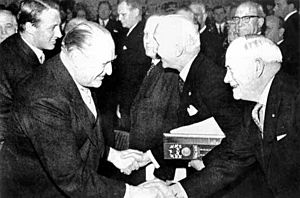
In 1952, the movement's rules were updated. From 1960 to 1970, many new national Red Cross and Red Crescent societies were recognized. By the end of the 1960s, there were over 100 societies. On December 10, 1963, the Federation and the ICRC won the Nobel Peace Prize.
In 1983, the League changed its name. It became the "League of Red Cross and Red Crescent Societies." This showed that more groups used the Red Crescent symbol. In 1991, its name changed again to the "International Federation of Red Cross and Red Crescent Societies." In 1997, the ICRC and IFRC signed an agreement. This agreement defined their roles more clearly. In 2004, the IFRC started its biggest mission ever. This was after the tsunami in South Asia. Over 40 national societies helped countless victims.
What the Red Cross Does
How the Organization Works
Around the world, about 97 million people work or volunteer with the ICRC, the International Federation, and the National Societies. Most of them are part of the National Societies.
Main Principles of the Movement
In 1965, seven basic principles were officially announced. These principles guide all parts of the Red Cross and Red Crescent Movement. They were added to the official rules in 1986. These principles were found by looking at what successful operations had in common over 100 years.
The definitions for each principle are a key part of the principle itself. They do not change over time or place.
| Principle | What it Means |
|---|---|
| Humanity | The Red Cross and Red Crescent Movement wants to help everyone. It started to help wounded soldiers without judging them. It tries to stop and ease suffering everywhere. Its goal is to protect life and health. It also wants to make sure people are respected. It helps people understand each other and promotes peace. |
| Impartiality | The Movement helps everyone equally. It does not care about nationality, race, religion, social class, or political views. It helps people based only on their needs. It gives help first to those who need it most urgently. |
| Neutrality | To keep everyone's trust, the Movement does not take sides in conflicts. It also does not get involved in political, racial, religious, or idea-based arguments. |
| Independence | The Movement is independent. National Societies help their governments with humanitarian services. They follow their country's laws. But they must always be free to act according to the Movement's principles. |
| Voluntary Service | It is a volunteer group that helps others. It does not try to make money. |
| Unity | Each country should have only one Red Cross or Red Crescent Society. It must be open to everyone. It must do its humanitarian work all over the country. |
| Universality | The International Red Cross and Red Crescent Movement is worldwide. All Societies are equal. They share responsibilities and duties in helping each other. |
International Committee of the Red Cross (ICRC)
ICRC's Purpose
The ICRC is a neutral and independent group. Its main purpose is to protect the lives and dignity of people affected by armed conflicts. In conflicts, it is the main organization leading the Movement's efforts.
What the ICRC Does
The ICRC's main jobs come from the Geneva Conventions and its own rules. They include:
- Checking if countries follow the Geneva Conventions during war.
- Organizing care for wounded soldiers.
- Watching how prisoners of war are treated.
- Helping find missing people in conflicts (tracing service).
- Protecting and caring for civilians.
- Helping solve problems between fighting groups.
How the ICRC is Organized
The ICRC's main office is in Geneva, Switzerland. It has offices in about 80 countries. It has about 12,000 staff members worldwide. About 800 work in Geneva. About 1,200 are international staff who manage missions. The rest are specialists like doctors or engineers. About 10,000 staff are from national societies working locally.
The ICRC is a private association under Swiss law. It is not a typical non-governmental organization (NGO). Only Swiss citizens can become members. The word "international" means its work is worldwide. The ICRC has special legal protections in many countries.
The ICRC has 15 to 25 Swiss members. They are chosen for four years. The main parts of the ICRC are the Directorate and the Assembly. The Directorate runs the daily work. The Assembly sets goals and checks finances. The president of the Assembly is also the president of the ICRC.
The ICRC often uses its French name: Comité international de la Croix-Rouge (CICR). Its symbol is a Red Cross on a white background. The words "COMITE INTERNATIONAL GENEVE" circle the cross.
How the ICRC is Funded
The ICRC's budget is over 1 billion Swiss francs. Most of this money comes from governments, including Switzerland. It also gets money from national Red Cross societies and international groups like the European Union. All payments are voluntary donations. The ICRC asks for money through annual appeals for its costs and emergency appeals for its missions.
In 2010, the ICRC asked for over 1.1 billion Swiss francs. Afghanistan, Iraq, and Sudan were its biggest operations.
International Federation of Red Cross and Red Crescent Societies (IFRC)
IFRC's Purpose and Jobs
The International Federation of Red Cross and Red Crescent Societies helps national Red Cross and Red Crescent societies work together. It also helps start new national societies. The IFRC organizes and leads aid missions after emergencies. These include natural disasters, epidemics, and large groups of refugees. The IFRC is the main organization for emergencies not caused by armed conflict.
The IFRC works with the national society in the affected country. It also works with national societies from other countries that offer help. About 25–30 national societies regularly help in other countries. The American Red Cross, British Red Cross, and German Red Cross are some of the most active. The IFRC also works to ban land mines. It provides medical and emotional support to people injured by land mines.
The IFRC's jobs include:
- Promoting humanitarian values.
- Giving aid in big emergencies like natural disasters.
- Helping national societies prepare for disasters. This includes training volunteers and providing supplies.
- Supporting local health care projects.
- Supporting youth activities within national societies.
How the IFRC is Organized
The IFRC's main office is in Geneva. It also has five zone offices and 14 regional offices. It has about 350 delegates in over 60 countries. The IFRC's rules are its legal basis. A Secretary General leads its main office.
The General Assembly is the IFRC's highest decision-making body. It meets every two years with delegates from all national societies. It elects the Secretary General. Between meetings, the Governing Board makes decisions. It includes the president, vice presidents, and elected representatives from national societies.
The IFRC's symbol combines the Red Cross (left) and Red Crescent (right) on a white background. It has a red rectangular frame.
How the IFRC is Funded
The IFRC's budget mainly comes from its member national societies. It also gets money from investments. The amount each member society contributes is set by a finance group and approved by the General Assembly. For extra funding, especially for unexpected emergencies, the IFRC publishes "appeals." These ask for voluntary donations from national societies, governments, other groups, companies, and individuals.
National Societies
Official Recognition
National Red Cross and Red Crescent societies exist in almost every country. In their home country, they act as national relief groups. The ICRC officially recognizes a relief society as a national Red Cross or Red Crescent society. The rules for recognition are in the Movement's statutes.
Here are some key conditions for a National Society to be recognized:
- It must be in an independent country where the Geneva Convention is in force.
- It must be the only Red Cross or Red Crescent Society in that country.
- Its government must officially recognize it as a volunteer aid group. It must help public authorities in humanitarian work.
- It must be independent so it can always follow the Movement's principles.
- It must use the Red Cross or Red Crescent name and symbol correctly.
- It must be organized to do its jobs, including preparing for conflicts.
- It must work across the entire country.
- It must welcome volunteers and staff without judging their race, gender, class, religion, or political views.
- It must follow the Movement's rules and work with other parts of the Movement.
- It must respect the Movement's basic principles and international humanitarian law.
Once the ICRC recognizes a National Society, it can join the International Federation of Red Cross and Red Crescent Societies. Today, there are 192 recognized National Societies that are members of the Movement. The most recent ones to be recognized are the Maldivian Red Crescent (2011), the Cyprus Red Cross Society, the South Sudan Red Cross Society (2013), and the Tuvalu Red Cross Society (2016).
What National Societies Do
Each national society is independent in how it works. But it must still follow its home country's laws. Many national Red Cross and Red Crescent societies have special rights. This is because of agreements with their governments or specific "Red Cross Laws." These laws give them the full independence needed by the International Movement.
Their duties include humanitarian aid in armed conflicts and emergencies. They help with things like natural disasters and finding missing family members.
Many national societies also do other humanitarian work. This depends on their resources. They might run blood donation services. Or they might provide civilian Emergency Medical Services (EMS). The ICRC and the International Federation work with national societies on international missions. They help with people, supplies, money, and logistics.
History of the Emblems
Symbols Used Today
The Red Cross
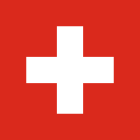
The Red Cross symbol was officially approved in Geneva in 1863.
The Red Cross flag is different from the Saint George's Cross. That cross is on flags like England's. To avoid confusion, the protected Red Cross symbol is sometimes called the "Greek Red Cross." The red cross on the Red Cross flag does not go all the way to the edges.
The Red Cross flag is like the Flag of Switzerland, but with colors swapped. This honors the Swiss for their work in protecting wounded soldiers. In 1906, it was officially stated that the Red Cross flag came from reversing Switzerland's colors. This was to show it was not a religious symbol.
In 1899, a convention said the Red Cross flag could be used on hospital ships. These ships had to fly their national flag and the white flag with a red cross.
The Red Crescent
The Red Crescent symbol was first used in the Russo-Turkish War (1877–1878). This was a conflict between the Ottoman Empire and the Russian Empire. The symbol was officially adopted in 1929. So far, 33 countries in the Muslim world use it. Like the Red Cross, the Red Crescent is also presented as a color-swapped version of the Ottoman Empire's flag. This helps show it is not a religious symbol.
The Red Crystal
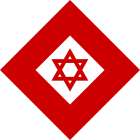
The ICRC worried that the Red Cross and Red Crescent symbols might seem religious. This could be a problem in countries with different main religions. So, in 1992, the president, Cornelio Sommaruga, said a third, neutral symbol was needed.
On December 8, 2005, a new symbol was adopted. It is officially called the Third Protocol Emblem, but is known as the Red Crystal. This happened to include Magen David Adom (MDA), Israel's emergency service. The Red Crystal was added by an update to the Geneva Conventions.
The Crystal is used on official buildings and sometimes in the field. It shows equality and has no political, religious, or geographical meaning. This allows any country that is not comfortable with the other two symbols to join the movement.
Symbols No Longer Used (but still recognized)
Red Lion and Sun
The Red Lion and Sun Society of Iran started in 1922. It joined the Red Cross and Red Crescent movement in 1923. This symbol was introduced in Geneva in 1864.
Because the symbol was linked to the Iranian monarchy, the Islamic Republic of Iran replaced it with the Red Crescent in 1980. Even though the Red Lion and Sun is not used anymore, Iran can still use it if they want. The Geneva Conventions still recognize it as an official symbol.
Symbols Not Recognized
Red Star of David
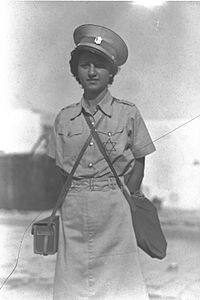
For over 50 years, Israel asked for a red Star of David to be added. They argued that if Christian and Muslim symbols were recognized, the Jewish symbol should be too. This symbol has been used by Magen David Adom (MDA), Israel's emergency service. However, it is not recognized by the Geneva Conventions as a protected symbol.
The Red Star of David is not protected outside Israel. So, the MDA uses the Red Crystal symbol for international work. This ensures they are protected. Sometimes, they put the Red Star of David inside the Red Crystal. Other times, they just use the Red Crystal.
Images for kids
-
Cross of the Serbian Red Cross Society
See also
 In Spanish: Cruz Roja para niños
In Spanish: Cruz Roja para niños
- American Red Cross
- Emblems of the International Red Cross and Red Crescent Movement
- First Aid Convention Europe
- International Committee of the Red Cross (ICRC)
- International Federation of Red Cross and Red Crescent Societies (IFRC)
- List of National Red Cross and Red Crescent Societies
- World Red Cross and Red Crescent Day
- UniRef


